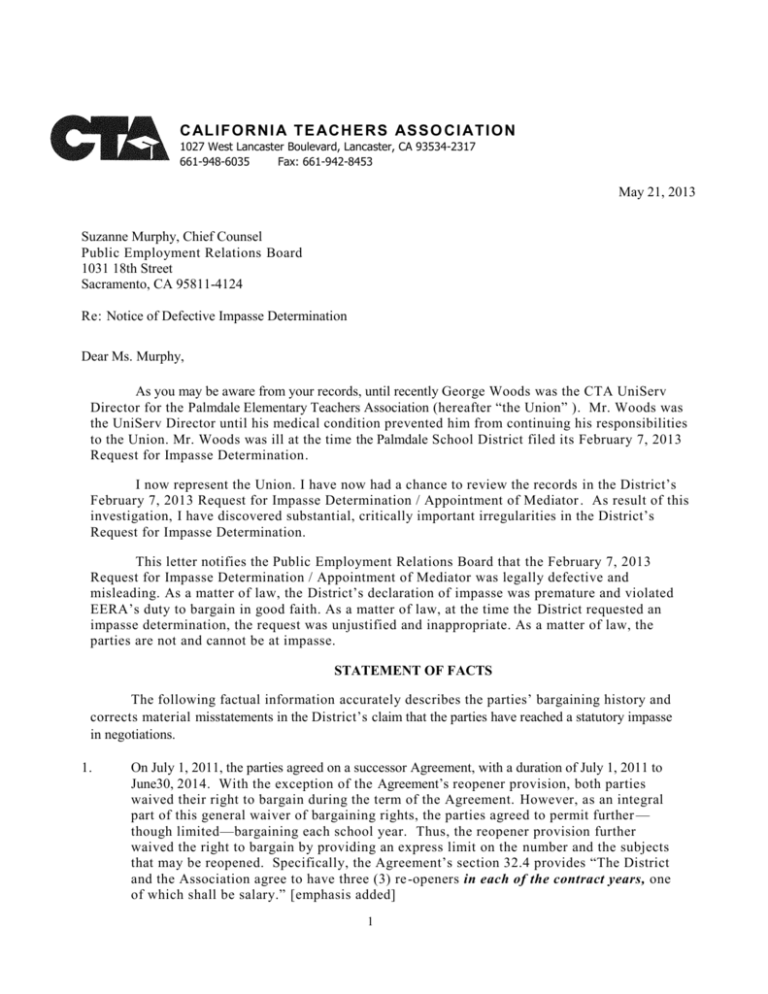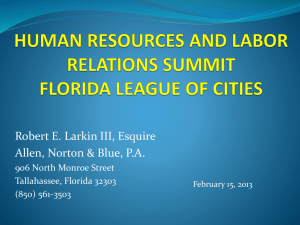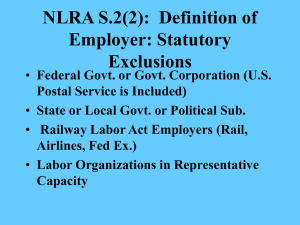CALIFORNIA TEACHERS ASSOCIATION 1027 West Lancaster
advertisement

C AL I F O R NI A T E ACHE RS AS S O CI ATI O N 1027 West Lancaster Boulevard, Lancaster, CA 93534-2317 661-948-6035 Fax: 661-942-8453 May 21, 2013 Suzanne Murphy, Chief Counsel Public Employment Relations Board 1031 18th Street Sacramento, CA 95811-4124 Re: Notice of Defective Impasse Determination Dear Ms. Murphy, As you may be aware from your records, until recently George Woods was the CTA UniServ Director for the Palmdale Elementary Teachers Association (hereafter “the Union” ). Mr. Woods was the UniServ Director until his medical condition prevented him from continuing his responsibilities to the Union. Mr. Woods was ill at the time the Palmdale School District filed its February 7, 2013 Request for Impasse Determination. I now represent the Union. I have now had a chance to review the records in the District’s February 7, 2013 Request for Impasse Determination / Appointment of Mediator . As result of this investigation, I have discovered substantial, critically important irregularities in the District’s Request for Impasse Determination. This letter notifies the Public Employment Relations Board that the February 7, 2013 Request for Impasse Determination / Appointment of Mediator was legally defective and misleading. As a matter of law, the District’s declaration of impasse was premature and violated EERA’s duty to bargain in good faith. As a matter of law, at the time the District requested an impasse determination, the request was unjustified and inappropriate. As a matter of law, the parties are not and cannot be at impasse. STATEMENT OF FACTS The following factual information accurately describes the parties’ bargaining history and corrects material misstatements in the District’s claim that the parties have reached a statutory impasse in negotiations. 1. On July 1, 2011, the parties agreed on a successor Agreement, with a duration of July 1, 2011 to June30, 2014. With the exception of the Agreement’s reopener provision, both parties waived their right to bargain during the term of the Agreement. However, as an integral part of this general waiver of bargaining rights, the parties agreed to permit further — though limited—bargaining each school year. Thus, the reopener provision further waived the right to bargain by providing an express limit on the number and the subjects that may be reopened. Specifically, the Agreement’s section 32.4 provides “The District and the Association agree to have three (3) re-openers in each of the contract years, one of which shall be salary.” [emphasis added] 1 2. On August 7, 2012, the District prepared an initial proposal and sunshined it on August 21, 2012. This initial proposal sought to reopen negotiations under the terms of section 32.4 by sunshining an initial proposal regarding employee health care that provided: “The District is submitting one of its three reopeners for the 2012 -2013 negotiations cycle.” 3. On November 27, 2012, the District made another proposal to reopen articles 4 and 14 on employee compensation and benefits and article 26 on class size for 2012-2013 negotiations cycle. 4. On January 31, 2013, the District proposed to bargain matters for the 2013-2014 negotiations cycle and for 2014-2015. This proposal includes a reduction in employees’ salaries, furlough days, and the hours of some employees for the 2013-2014 and 2014-2015 school years. 5. Thus, the District attempted to bargain a matter beyond the section 32.4 limits on reopening the Agreement. Specifically, the District attempted to bargain changes in Agreement for the 2014-2015 school year. 6. On or about February 7, 2013, the District filed a petition for impasse determination with your Glendale office. This request was docketed as LA-IM-3758-E. The District checked the box for type of dispute that reads “[r]eopener(s) in Existing Contract.” The District’s request also represented that the parties have four (4) unresolved issues. 7. However, the District’s description of the issues remaining in dispute failed to disclose that negotiations concerned “reopeners for the 2013-2014 negotiations cycle” and that the District’s proposals included changes in the Agreement for the 2014-2015 school year. Further, the District’s 2014-2015 proposals cannot be accurately characterized as a dispute over “[r]eopener(s) in Existing Contract.” As a result, the Districts’ February 7, 2013, petition for impasse determination was legally defective. 8. The Union understands and believes that the District failed to disclose the facts, described in paragraphs 4, 5, and 7, above, to PERB Regional Attorney Yaron Partovi during the impasse investigation. As a result, the District’s February 7, 2013 impasse determination misrepresents material facts related to both the parties bargaining history and the existence of an impasse. 9. Under the current Agreement’s sections 32.1 and 32.4, the District’s 2014-2015 proposals are permissive subjects of bargaining. As you know, it is clear that insisting to impasse on a permissive subject of bargaining violates EERA’s duty to bargain in good faith. For this reason, too, the District’s February 7, 2013, petition for impasse determination was legally defective. 10. As a consequence of the facts the District withheld regarding impasse in this dispute, Regional Attorney Yaron Partovi’s determination of the existence of an impasse is factually inaccurate and legally defective. 11. Additionally, the parties’ bargaining resulted in an agreement on nineteen (19) issues in the current negotiations cycle. 12. Further, the Union has not reached its “bottom line” over the issues remaining in the current negotiations cycle. If the District were to bargaining in good faith on these issues, the Union is prepared make substantial concessions that would certainly move the parties much closer to an agreement. If the District were to bargain in good faith on these issues, the Union’s substantial concessions might actually produce a voluntary settlement. 2 13. Therefore, the Employer’s unilateral declaration of impasse is premature for the following reasons: a. The parties have no current legal obligation to bargain any matter beyond the term of the current contract that is in full force and effect until June 30, 2014. b. The District violated its duty to bargain in good faith by insisting to impasse on a permissive subject of bargaining. c. The parties are not in a deadlock over any matter in the current negotiations cycle permitted under the Agreement’s section 32.4. d. The Union is prepared to continue negotiations on matters in the current negotiations cycle permitted under the Agreement’s section 32.4. The Union is also prepared to make substantial concessions that would certainly move the parties much closer to an agreement. ARGUMENT Under ERRA the existence of an “impasse” involves both a factual determination and a legal conclusion about the parties’ bargaining practices. “Impasse” means that the parties to a dispute over matters within the scope of representation have reached a point in meeting and negotiating at which their differences in positions is so substantial or prolonged that future meetings would be futile. The legal determination that true “impasse” exists carries very significant consequences. As you know, the statutory consequences of “impasse” consist of the following: EERA suspends the bargaining parties' Duty to Bargaining in good faith; EERA imposes mandated mediation pursuant to section 3548; Failing voluntary agreement through the assistance of mediation, EERA imposes mandated factfinding pursuant to EERA section 3548.1; Failing voluntary agreement through the assistance of mandated factfinding or voluntary continued mediation pursuant to EERA section 3548.4, EERA permits a public school employer to lawfully change the status quo antes by unilaterally imposing its "last, best, and final offer" on its employees; and Failing voluntary agreement through the assistance of mandated factfinding or voluntary continued mediation pursuant to EERA section 3548.4, EERA permits public school employees to lawfully strike their public school employer. As a result, both EERA and PERB’s own regulations strictly prescribe the pre-conditions that must exit before a PERB board agent investigating an impasse claim can make the determination. Specifically, EERA mandates that three pre-conditions must exist before a true, bona fide “impasse” exists. Absent clear evidence of these conditions, PERB may not determine the existence of an impasse, suspend the parties’ duty to bargain in good faith, or require the parties to participate in and exhaust EERA's Impasse Procedures. The three limits on PERB authority to declare the existence of an impasse are: 1. The first precondition for “impasse” is that the party petitioning for an impasse determination must have, at all times, complied with EERA' Duty to Bargaining in good faith. PERB may not find an impasse where the evidence shows that the parties failed to engage in meaningful discussions over bargaining 3 proposals or offer counter-proposals. Here, the union has no current legal obligation to bargain with the District over matters taking effect beyond the term of the current contract. Moreover, as described above, the District breached its duty to bargain in good faith by insisting to impasse on permissive subjects that take effect beyond the term of the current contract. Further, the District has disclosed its intention to violate the duty to bargain in good faith by maintaining an inflexible predetermined bargaining position that is predictably unacceptable to the union. Therefore, the first precondition for a true impasse has not been met. 2. A second precondition for “impasse” is that the bargaining parties have “met and negotiated” within the meaning of subdivision 3540.1(h), but have reached a deadlock over all significant issues necessary for mutual agreement over the matters in dispute. Here the parties have not met and negotiated within the meaning of EERA Section 3543.1(h) and have not reached a deadlock over matters in dispute in the current negotiations cycle permitted under the Agreement’s section 32.4. As a result, the parties have not bargained to a “deadlock” Therefore, the second precondition for a true impasse has not been met. 3. The third precondition for “impasse” is that continued meeting and negotiating would be futile, because “their differences in positions are so substantial or negotiations have been [so] prolonged” that no voluntary agreement is possible without assistance from EERA's section 3548 Impasse Procedures. The parties met and negotiated, but the District prematurely terminated bargaining by filing the February 7, 2013, petition for impasse determination impasse. As a result, it is impossible to determine whether bargaining would produce a voluntary agreement. However, it is certainly premature to conclude that further bargaining would be futile or that the parties cannot reconcile their differences through negotiations. Therefore, the third precondition for a true impasse has not been met. EERA mandates that these three preconditions must be met before PERB has the legal authority to declare the existence of an “impasse.” PERB's own regulations explicitly guide the investigation of these three preconditions. Specifically, PERB board agents must consider at least four factors in determining whether an impasse exists. These factors include: 1. The number and length of negotiating sessions and the period over which these sessions occurred. Here, the parties met and negotiated on only four (4) occasions and for only 28 hours. As a result of this this short period of bargaining, the District preempted the bargaining process by prematurely declaring impasse. Certainly, it is impossible to determine whether bargaining would produce a voluntary agreement as the legislature intended when it enacted EERA. However, EERA mandates that PERB give the parties an opportunity to meet and negotiate to reach a voluntary agreement. Therefore, the employer's impasse determination request is premature. 2. The extent to which the parties presented and discussed counterproposals. Here, the parties met and negotiated, but the parties bargained on only two (2) occasions after the District presented its 2013-2014 and 2014-2015 proposals. By seeking an impasse determination, the employer is attempting to avoid the normal give and take of negotiations that produces mutual agreement. Therefore, the employer's impasse determination request is premature. 3. The extent to which the parties reached tentative agreements on negotiated issues. Here, the parties met and negotiated and reached tentative agreements on some nineteen (19) 4 issues! Up until the time the District declared impasse, the collective bargaining process was functioning well. However, neither the employer nor PERB can predict or presume that the parties cannot reach agreements were bargaining to continue on benefits. Therefore, the employer's impasse determination request is premature. 4. The extent to which issues remain unresolved. Here, the parties met and negotiated with only four (4) out of nineteen (19) left unresolved. However, neither the employer nor PERB can predict or presume that the parties cannot resolve issues were bargaining to continue. Therefore, the employer's impasse determination request is premature. A party declaring impasse and petitioning the PERB for an impasse determination carries the burden of credibly demonstrating that: (1) the party has complied with EERA's Duty to Bargain in good faith; (2) the bargaining parties are deadlocked on all important issues; and (3) continued meeting and negotiating would be futile. The mere desire of a public school employer to cease meeting and negotiating is not sufficient to create an impasse. PERB’s Mt. San Antonio holding emphatically emphasizes this conclusion. Here, the parties' bargaining history does not offer creditable evidence that any of these three conditions for a true impasse actually exist. Moreover, the facts here do not support a conclusion that parties have reached a true impasse under the four factors mandated by PERB's own regulations. EERA delegates determination of impasse to PERB's board agents. However, a Board Agent can exercise PERB’s statutory authority to determine that an impasse exists, only if the party petitioning for the impasse determination can evidence a credible basis for the existence of all three preconditions. Where one party misrepresents or withholds material facts, their request for an impasse determination is legally defective. CONCLUSION The employer's claim that the parties have reached impasse when the employer just says so is obviously untenable. The audacity of the claim also makes the employer's argument novel. Because it misrepresented and failed to disclose material facts related to the parties’ bargaining, the District’s request for an impasse determination is legally defective. As a consequence, any resulting PERB impasse determination is also legally defective and it lacks force and effect. The union is prepared to file legal briefs on the matters alleged in the employer's impasse determination request and the Union's response here. Should a full briefing of the issues be useful in your investigation, please let me know. For the reasons I discussed above, PERB must withdraw is determination that the parties are at impasse. This would permit the parties, an opportunity to resolve their issues at the bargaining table. The parties' collective bargaining agreement currently provides this opportunity. PERB should respect the parties' agreement and give the parties what they bargained for, i.e., reopener bargaining within the scope of the Agreement’s section 32.4. Very truly yours, Paul Scott CTA Regional UniServ Staff 5 6






